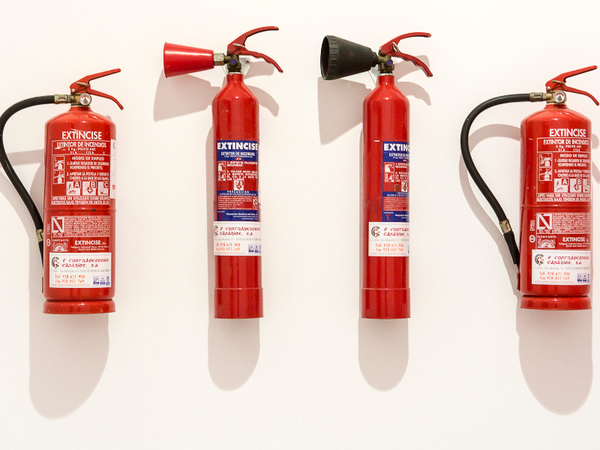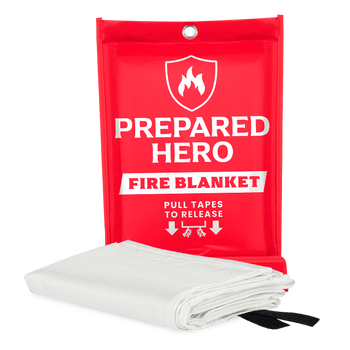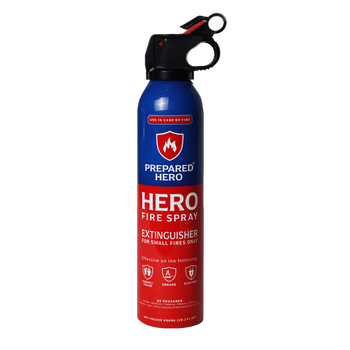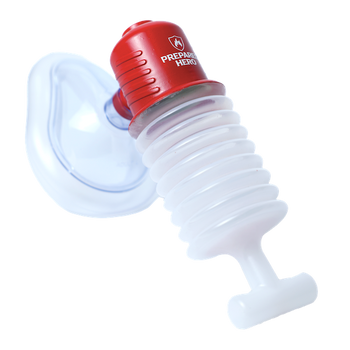Where you put your smoke detectors matters just as much as installing them. Proper placement makes sure they can detect...
Not all fires are the same, and using the wrong method to put one out is dangerous. Some fires are safe to put out with water, while others are not. If you’ve been wondering what type of fire can be put out safely with water, we’re here to help. In this guide, we’ll break down the different fire types, when to use water, and when not to use water. We’ll also give you alternatives to water for emergencies where you can’t use it.
Types of Fire

There are many types of fire based on what’s burning. Understanding them helps you see which ones can be safely put out with water. It also helps you stay prepared and respond safely. Here are the different kinds of fire:
Class A Fire
A Class A fire involves ordinary materials commonly found in homes, offices, and outdoors. These include wood, paper, fabric, plastic, and cardboard. These items can catch fire easily when exposed to enough heat or flame, making them significant fire hazards.
Class A fires can start in everyday situations. For example, a cluttered room with piles of paper can quickly catch fire if a spark or ember lands on it. Leaves and grass are also especially vulnerable to fires during dry weather, especially when people aren’t careful with heat sources like matches and cigarettes.
In addition, Class A fires spread fast because the materials are highly flammable. Once they start, they can quickly consume nearby furniture, curtains, and other household items. The smoke can also be toxic and fill up a room quickly, making it dangerous for anyone inside.
Class B Fire
Class B fires involve flammable liquids and gases, which are often found in garages and industrial settings. These include gasoline, alcohol, paint thinner, propane, and methane. Class B fires can start because of spills or leaks. For example, a Class B fire can ignite if gasoline spills and someone lights a match nearby. Many of these liquids also release vapors, which are just as dangerous. If those vapors build up in a closed space and meet a heat source, they can catch fire.
In addition, Class B fires spread quickly and burn intensely, which makes them dangerous. For example, a small gasoline leak in a garage can turn into a major fire in seconds. The same thing applies to LPG (liquefied petroleum gas), which is commonly used in cooking.
Common causes of Class B fires include improperly stored cleaning products, aerosols, and fuels. The risks are higher when flammable liquids or gases are near heat sources because they can lead to explosions if mishandled.
Class C Fire
A Class C fire occurs when electrical equipment catches fire. This type of fire involves energized equipment that’s connected to a power source. As long as the power stays on, the fire can keep spreading.
What makes Class C fires risky is how fast they grow. Once something like a faulty wire or malfunctioning appliance ignites, the fire can quickly spread to other areas or cause an explosion. Since many electrical wires are hidden behind walls or ceilings, these fires can go unnoticed until they’ve already caused serious damage. For this reason, it helps to know what an electrical fire smells like.
Common causes of Class C fires include faulty wiring, overloaded outlets, malfunctioning appliances, and overheating electronics. For example, a toaster can catch fire if it starts smoking and sparks land on nearby items. These fires can get out of hand fast, so it’s important to turn off the power if one happens. Remember, never use water to put out a Class C fire because you might get electrocuted.
Class D Fire
Combustible metals like magnesium, lithium, and sodium cause class D fires. These fires are different from regular ones because they can burn at higher temperatures and explode. They can also react violently with water or air.
Class D fires usually happen in industrial settings where metals are processed or stored, like factories or welding shops. They often start when metal dust, shavings, or molten metal come into contact with sparks or flames. For example, a spark in a factory can ignite metal shavings and quickly escalate into a serious fire.
These fires can also cause severe burns, respiratory problems, and permanent injuries. The financial impact can be huge, too, given property damage and lost production time. In some cases, the business might go bankrupt if the damage is bad enough.
Class K Fire
Class K fires are caused by cooking oils, fats, or grease catching fire. Grease fires usually start in kitchens, both at home and in restaurants, where oil is used. The dangerous part? These fires can spread quickly, and you can’t use water to put them out.
For example, vegetable oil can ignite at temperatures between 410°F and 633°F. Once it catches fire, its temperature can go up fast. The fire can also get worse if other kitchen hazards are nearby.
Class K fires can be devastating. They can cause burns, respiratory issues from smoke, and death. They can also bring big financial burdens, including medical bills and repair costs.
Common causes of Class K fires include leaving hot oil unattended, deep frying, grease buildup, and cooking near flammable items. Plus, using the wrong fire extinguisher can make things worse. It helps to have a fire blanket around because they quickly work against grease fires.
What Type of Fire Can Be Put Out Safely With Water?

You can safely put out Class A fires with water. These fires involve common materials like paper, wood, cloth, rubber, and plastic. Water is effective against Class A fires because it cools the fuel down. As a result, its temperature goes below the point where it can continue to burn. Water also helps smother the fire by reducing the amount of oxygen around the flames.
In particular, water absorbs the heat from the burning materials and turns it into steam. This steam helps further cool down the fire and prevent it from spreading. Essentially, water breaks the fire cycle by removing heat. Fires need heat, fuel, and oxygen to keep burning. The combination of these is known as the fire triangle. Water takes away the heat when you pour it on fire, which is a key part of what keeps the fire going.
But here's the thing—just pouring a little water won’t do the trick. You need enough water to cool things down. If you don’t use enough, the fire could reignite once the heat builds up again. It might seem like the fire is out, but if the material is still hot, it can catch fire again. So, make sure to keep applying water until everything cools down.
In addition, water fire extinguishers are specifically designed for Class A fires. They spray water onto the flames, cooling and soaking the material until the fire goes out. These extinguishers are often found in places with ordinary combustibles, like offices, homes, and schools. While water fire extinguishers can be used for other types of fires, water alone should only be used on Class A fires.
However, water is not always the right choice for every fire. For example, you should never use water on electrical or grease fires. Water can conduct electricity and electrocute you when used on electrical fires. It also splatters the oil and causes the fire to spread quickly when used on grease fires. Remember to use the right fire extinguisher based on the type of fire you’re dealing with.
How to Use Water to Safely Put Out a Fire

Putting out a fire with water seems easy, but there’s a right way to do it. Follow these steps to make sure you stay safe while effectively handling Class A fires:
1. Stay calm.
First, make sure it’s safe for you to act. If the fire is out of control, evacuate and call for help immediately. If it’s small and manageable, proceed to the next steps.
2. Grab your water source.
You can use a hose, a bucket of water, or a water fire extinguisher. Make sure you have enough water to fully put out the fire. If you're using a bucket, fill it up before approaching the fire.
3. Get close, but stay safe.
Approach the fire slowly. Make sure you’re at a safe distance from it. For instance, you can stand close enough to pour water on a fire in a trash can, but not on a huge bonfire.
4. Aim at the base of the fire.
Aim the water at the fire's base. This is where the fuel is, so cooling it down will help stop the fire from growing. Aim low and stay steady with your stream of water.
5. Continue applying water until the fire is out.
Don’t rush. Completely drench the fire and keep spraying or pouring until there’s no smoke or heat. Check for any hidden embers or hotspots as well. Use more water if needed to make sure it’s fully extinguished.
When Not to Use Water

You should never use water to put out certain fire types, specifically Class B, C, D, and K. Here’s why:
Class B Fires
Class B fires involve flammable liquids and gases like gasoline and propane. Using water on them can make the fire worse. Flammable liquids and gases are volatile, and water can make the fire spread or react violently. For instance, pouring water on a gasoline fire can push the fuel around and spread the flames. This is because water and gasoline don’t mix.
Class C Fires
Water is a conductor of electricity, so using it on an electrical fire can electrocute you. If there’s any live current, water will carry the electricity and make things even worse. You need a Class C fire extinguisher that doesn’t put you at risk of electrical shock.
Class D Fires
Class D fires involve combustible metals like magnesium or sodium. These fires burn at much higher temperatures and react violently with water. If you try to put out a metal fire with water, the fire might explode. Water makes these fires much more dangerous and harder to control, so use Class D fire extinguishers instead.
Class K Fires
Water makes grease fires much worse by splattering the burning oil. This can spread the fire all over the place, including nearby flammable items. Water also increases the chance of the fire igniting nearby surfaces.
What to Do Instead
You can only use water on Class A fires, so you need other tools to put other fires out. Each tool has its benefits, depending on the fire you're dealing with. Having the right tool prepares you for whatever comes your way.
1. Fire Blankets

Fire blankets are versatile and can be used on all types of fires. These include grease fires (Class K), electrical fires (Class C), flammable liquid and gas fires (Class B), and small metal fires whose temperatures are not higher than what they can handle.
They work by smothering the flames and cutting off the oxygen supply, stopping the fire from spreading. The main benefit is that they’re simple to use. Just throw the blanket over the fire and wait for it to die. They’re also portable and can be kept in handy locations like kitchens or cars. Plus, you don’t need special training to use fire blankets, making them a quick option during an emergency.
2. Fire Sprays

Fire sprays are another great option for handling many fire types, including grease fires. They’re portable, easy to use, and often come in compact sizes. You can easily store them in places like cars, kitchens, or workshops. They work by creating a barrier between the fire and the fuel and cooling down the flames quickly.
3. Fire Extinguishers

Fire extinguishers are your go-to when it comes to more specific fires. Each type is designed for a particular class of fire. For example, a Class B fire extinguisher is perfect for flammable liquid fires like gasoline or oil, while a Class C fire extinguisher is used for electrical fires. Class D extinguishers are designed for metal fires, while Class K fire extinguishers are made for grease and oil fires. Fire extinguishers are reliable once you know which one to grab.
Conclusion
You can use water on Class A fires, but it’s not always the answer. Knowing when to use alternatives like fire blankets, sprays, or extinguishers keeps you safe. Fire safety isn’t just about reacting. It’s also about being ready with the right tools and knowledge.
Do you want reliable, easy-to-use, and affordable tools to put out small fires before they spread? Check out Prepared Hero’s fire prevention tools here, and get up to 51% off on certain items. Stay prepared, hero!


 Fire
Fire Safety
Safety Survival
Survival Protection
Protection New
New
 Fire
Fire Safety
Safety Survival
Survival Protection
Protection New
New












